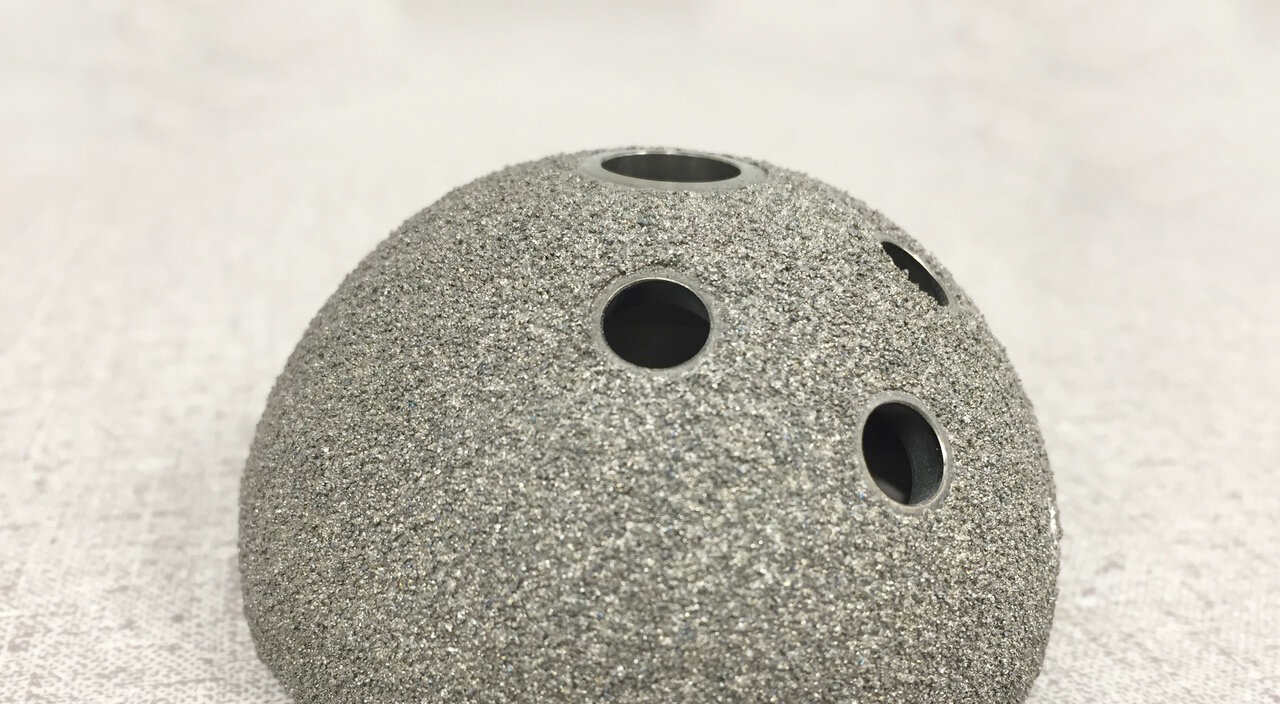Hipper than Ever: Advancing Technologies Make Hip Replacements Viable for a Younger Population
Detail of titanium acetabular cup with a customized textured surface to encourage stronger osseointegration with the pelvic bone.
When you picture a typical hip replacement candidate, you likely think of someone aged 60 or 70, not 40 or 50. Up until recently, that assessment was in line with reality. The main reason older adults have been more likely to receive a hip replacement is fairly obvious: as people age, their joints are more likely to degenerate to the point where surgery is required.
The other reason might be less obvious. HIstorically, the materials and techniques used in hip replacement surgery, or total hip arthroplasty (THA) didn’t result in a prosthetic that lasted very long. The materials would degrade over time with continued use, or the implant would begin to dis-integrate with the body. When implanted in a younger patient, the likelihood of a revision surgery, or a surgery to replace the artificial hip was very high.
As pointed out in this PopSci article, today the average age of hip replacement patients is dropping. (The author of the article had his own hip replaced at the age of 39). Many younger patients do in fact suffer from conditions like osteoarthritis, a painful condition that stiffens the hip joint, as well as other conditions, such as those caused by injury, that produce irreversible damage to the joint. Even though these patients are young, often THA is the best solution for an improved quality of life.
Thanks to steady improvement in both the techniques and materials used in hip replacement surgeries, younger patients are now benefiting from THA, without the higher risk of implant failure, which necessitates repeated surgery.
Advanced materials for artificial hips
Some of the earliest artificial hips were made from materials that included wood, gold foil, glass, wax, and rubber among others—none of which are still in use today. In modern THAs, the most common artificial joint materials consist of different combinations of metal, polyethylene, and ceramics. One of the most popular configurations is a metal stem and ball that fit into a polyethylene acetabular (hip socket) cup.
Anteroposterior x-ray detail of pelvis with total hip replacement that includes an acetabular cup in the hip socket and a ball and stem implant connecting the new joint with the femur. Source image courtesy Mikael Häggström, M.D. via Wikimedia Commons.
The metal components are largely made from titanium alloys and cobalt chromium alloys, both of which provide excellent strength and wear-resistant properties.
To improve the efficacy of an implant, a surface treatment is applied that renders the metal porous. This helps encourage the surrounding bone to grow into the implant, integrating it into the body. Himed uses a micro-abrasive grit-blasting treatment called Matrix MCD to create a complex, porous surface on implants, which results in better osseointegration and reduces the probability of subsequent revision surgeries.
Advancements in the structure of polyethylene have also helped. Specifically, the development of cross-linked polyethylene has increased the material’s wear resistance, resulting in stronger, more durable artificial joints. The improvement significantly decreases a major issue implants face: the shedding of debris over time as the joint moves and is used. The body will often detect these tiny particles and attack them as foreign objects, as with an infection. The attack will often damage the bone surrounding the implant, leading to its loosening, and eventually a revision.
A third component of many modern hip replacements is bone cements, either on the stem component that implants into the femur, the cup component implanted into the hip bone, or both. These cements are often created from the raw material hydroxyapatite, a critically important substance we explored in our last blog post.
The future of hip replacements
Hip replacement techniques and materials have improved significantly, allowing younger patients the ability to benefit from the surgery. But there is still room for improvement. Developing materials with the least amount of wear debris will improve every patient’s outcome. Techniques that improve the osseointegration of the implant, such as through antibiotic or responsive biomaterials, will help decrease the need for invasive revision surgeries, improving the quality of life for those in need of THA—regardless of age.


